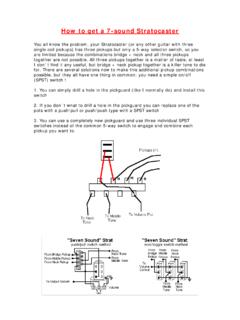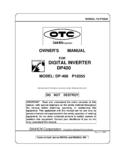Transcription of Protect yourself from electrical shocks - …
1 Protect yourself from electrical shocks You all know the stories about musicians who died from electrical shocks while playing electric guitar. The reason for this is that the strings are normally connected to ground for hum-cancelling reasons, especially on single coil guitars and a damage or malfuntcion of your amp can send a lethal electrical shock that will hit you while touching the strings. Here is how you can Protect yourself from being grilled while playing. The most simple solution is to disconnect your strings from ground by cutting the cable, eg. from underneath the bridge on a Tele. If your guitar is well shielded this can work. I suggest to try this first, if your guitar is silent, producing no noises or hum leave it the way it is and you are save. If this will not work and your guitar is humming, there is another cheap trick to make your guitar save while the strings are still connected to ground. All you need is a (=1nF) cap with a minimum rating of 500 volts or higher and a 220k resistor.
2 Wire both parts in parallel, solder a piece of wire at both ends (1mm diameter or higher recommended) and wrap the hole thing with insulating tape to make it save from being shorted. Cut the wire that grounds the strings and insert the wrapped "fuse" between the both open ends like shown in the drawing. If now a damage accures our new "fuse" will limit the shock to approx. 40. volts which is not dangerous for humans. You will feel the electrical shock, but it will not hurt you and it is a good indicator that there is something wrong with your amp. Unplug your amp immediately by pulling the power cord. Don t touch any parts of your amp and don t try to turn it off by using the on/off switch !!!!! Your amp needs professional maintenance now. Available at the singlecoil-webshop ( ). Technical backgrounds (from ). The most important thing for musicians, and especially guitarists, to understand is that "ground" isn't always ground! While the negative side of the input jack on your amplifier is often called "ground" it actually may be at a lethal voltage when referenced to "earth" ground or to "ground" on another piece of equipment.
3 Furthermore, even when your equipment is operating perfectly it can still carry a lethal charge when you are plugged into an improperly wired mains power source. Finally, even when your equipment is working perfecty and is plugged into a properly grounded mains outlet, you may be using other equipment that is not properly grounded "ground" on that equipment may be at a lethal voltage referenced to ground on your equipment. In all three of the above scenarios your body may be the path of least resistance between one voltage level and another significantly different voltage level whenever that happens you are an electrocution looking for a place to happen. There are three shock scenarios the guitarist faces. These scenarios are not "theoretical," musicians have died! 1. Failure of the guitarist's own amplifier places a lethal voltage on the "ground" side of the jack and thus on the strings. This scenario is usually only encountered on early vintage equipment. Even then such failures are extremely rare but when they occur they can place hundreds of volts DC on the "ground" side of the jack and the failure may be difficult to detect until the shock knocks you on your backside.
4 This failure is basically impossible with modern three-prong equipment plugged into a properly grounded three-prong mains outlet. Never use ground lift adaptors on power cords! The shock path is from the amplifer, through the guitar chord to the guitar bridge and strings, to the guitarist's fingers. From there the shock path either goes through the guitarist to the floor through his feet or through the guitarist to a grounded piece of equipment such as a microphone. Even the first path through the resistance of shoes and floor covering may sometimes be lethal because the voltage potential is so high. The second path is easily lethal because the path from the guitarist to earth ground has very little resistance to the flow of current. 2. The guitarist's equipment is okay, but improper mains wiring places a lethal voltage (referenced to earth ground) on the "ground" side of the jack. This voltage could be either AC or DC, depending on the design of the equipment. This occurs most often when the earth ground of the mains wiring is not connected and the "neutral" and "hot" sides of the outlet are reversed.
5 This scenario is much more common than it should be it seems far too many club owners have all their wiring and remodeling done by half-wit inlaws. Fortunately, this is also the easiest scenario to detect and prevent. Every gigging musician should have one of the simple three-prong testers that are sold for a few bucks in hardware stores and should use it every time they set up for a gig even if they've played the venue a thousand times. The shock path is similar to that of scenario one, above. In this case the path through the feet (and the resistance of shoes and floor covering) can be painful but is less likely to be fatal because the voltages are lower than those of scenario one. However, the path through another piece of equipment can still easily be fatal. 3. The guitarist's equipment may or may not be okay and plugged into good mains wiring, but in either case other equipment in use is plugged into improper mains wiring. This results in a lethal potential on other equipment, such as microphones, when referenced to the guitarist's equipment.
6 Again, this voltage could be either AC or DC, depending on the design of the equipment. This scenario is also much more common than it should be and for the same reasons given in scenario two, above. This is a slightly more difficult scenario to detect in that you not only have to test the outlets you'll be using, you also have to bug the club manager to let you test the outlets powering the house equipment (PA, mixer, etc.). Here the shock path is from the improperly grounded equipment (PA, mixer, etc.) through gear the guitarist is using (maybe a microphone) then through the guitarist's body and either to earth ground through the guitarist's feet (when the guitarist is not touching the strings) or through the guitarist's hand to the strings and bridge then the guitar cord and finally the guitarist's grounded equipment. Again, the second path is far more likely to be lethal. Keep in mind that any of the above scenarios can involve more than one musician. Two guitarists can shock each other if their amps are on different polarity mains circuits.
7 A. guitarist and lead singer can fry each other if either the guitarist's amp or the PA or mixer that the singer's microphone is attached to are on bad wiring. I play mostly to my bedroom walls and occasionally in church so I had assumed that scenarios two and three, both representing shock hazards caused by faulty and illegal mains wiring, had all but been eliminated at least in the lawsuit-happy USA. A recent (1998) discussion on reveals that I sadly underestimated the greed and carelessness of some club owners and the ignorance and/or desparation of some working musicians. At least in the United States there is absolutely no reason for a musician to be shocked because of poor wiring at a venue. First, for a few bucks you can get an outlet checker at any hardware store. This is a three-prong plug with some LEDs that you simply plug into the outlet. When you set up for a gig check all the outlets with the checker. Also, insist on checking the outlet that the house PA is plugged in to if you are going to be using equipment through the house PA.
8 Finally, and especially if unable to check the house PA outlet, fire up all the equipment and then gently touch your guitar strings against the microphone or other equipment if you see an arc you have a potentially lethal situation. (Note, some worry that this might damage their guitar such damage is very unlikely but even if it occurs it is less trouble than the damage to you that might occur otherwise.). I suspect that most club management will be happy to fix their wiring if you politely explain the potential hazards to their customers, employees, and visiting musicians. I. think most club managers are just ignorant of the real danger and see musicians as whiners worried about damage to their equipment. Explain the real hazard and the potential lawsuits and I think they'll come around. If not, find out who insures them. In some places they have to post that information publicly on the premises while in others it isn't posted but is available to the public at the office of the agency issuing their occupancy permits.
9 Explain the situation to the insurer. If that doesn't work (extraordinarily unlikely!) a phone call to the proper authorities should bring quick action. If the local fire department doesn't do electrical inspections they'll know what agency does. Okay, so all of the above remedies assume that you have the courage to insist on safe wiring in the venues you play. Let's assume for the moment that you're one of those people who is so desparate for a gig that you would rather risk death than the wrath of a club manager how can you still Protect yourself ? Use a wireless system on your guitar. This will Protect you completely from shock scenarios one and two and from the most lethal path of shock scenario three. The absolute safest way to go is with a wireless microphone and a wireless on your guitar. Disconnect the bridge ground wire on your guitar or use a small (about .02uf). capacitor shunted by a large (about 220k) resistor to isolate the bridge from the rest of the ground. Note that this may significantly increase the amount of hum you experience.
10 Also note that this is only a partial fix the jack plate and some other exposed metal parts (including metal volume and tone knobs) of your guitar and amplifier will still be potentially lethal. Use only modern equipment with three-prong grounded plugs. Never use ground lift adaptors or switches on the power connection. Never use polarity switches. When practical plug all of your equipment into a single outlet at the venue by using a power strip or power conditioner. This way at least all of your equipment will be at the same potential and polarity though you still have to be very cautious about other equipment. Obviously, you can't do this if you've got a lot of high- power equipment. If you are gigging, a top-notch power conditioner is a good investment anyway because it can help prevent noise from lighting equipment and such from getting into your equipment through the power. Learn to be very conscious of the equipment around you and to avoid touching other musicians, microphones, etc.









